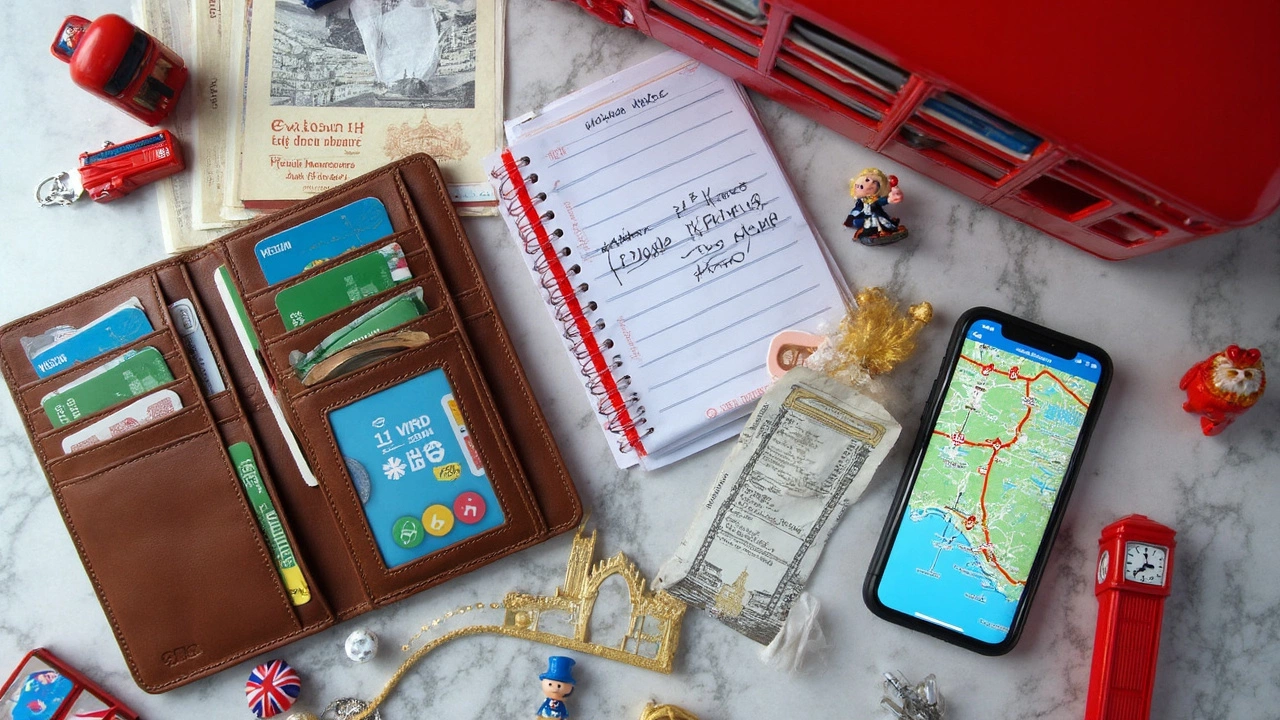Good Budget for a 3-Day City Break: What to Expect
 May, 10 2025
May, 10 2025
Ever tried to plan a quick getaway and felt lost when it comes to how much cash you actually need? You’re not alone—city breaks can be sneaky with their costs. Whether you’re catching cheap flights or eyeing a fancy long weekend, your budget can make or break the fun.
You might think you need a ton of money for just three days away, but that’s not always true. The right budget depends a lot on where you’re going, what kind of place you want to stay at, and how you plan to move around the city. Sure, Paris and London will hit your wallet harder than Budapest or Lisbon. But there’s always a way to trim costs—or go all out if you’re up for it.
Getting your budget sorted upfront means fewer nasty surprises, no panicked ATM runs, and way more time to chill or explore. A lot of the little things—like admission tickets, quick snacks, and metro passes—add up way faster than most people expect. That’s why knowing what to expect is the real game changer. Ready for the real numbers and tricks?
- What Decides Your Budget?
- Comparing Costs: Cheap, Mid-Range, and Splurge
- Breakdown: Where the Money Goes
- Smart Ways to Save on a City Break
- Sample Budgets: Real Numbers for Popular Cities
What Decides Your Budget?
There’s no secret formula when it comes to city break spending—it’s all about a few main things that you can actually control. First up, where you’re going makes a massive difference. Cities like Prague, Budapest, and Porto are known for being wallet-friendly, while places like London, Paris, and Copenhagen tend to drain bank accounts faster.
Next, when you go matters. Traveling in peak season (think summer months or during popular festivals) can bump prices for almost everything, from rooms to restaurants. Off-season or mid-week? Chances are you’ll save a bunch.
Accommodation usually makes up the biggest slice of your city break budget. Hostels or budget hotels can be as low as $30 a night in some spots, but nice hotels in top cities? Not unheard of to hit $200+ for a double room, even during non-peak periods.
Food can sneak up on you too, especially if you gravitate toward busy tourist areas. The cost swings wildly: street food for $3 to $5 a meal in many European spots, up to $40 per person at a sit-down place in Paris or Rome. Throw in coffee breaks and midnight snacks, and you’ve got a decent chunk set aside just for eating.
Local transport is usually pretty fair in most cities. A day pass for public transport in Berlin or Vienna will set you back about $9 to $10. Some cities offer tourist cards that mix free transport with entry to museums (like the London Pass or Paris Museum Pass), which can be a good deal if you plan on seeing a lot.
“City breaks can fit nearly any budget, but knowing the average daily costs in your destination is where it all starts. People usually underestimate how quickly small splurges add up,” — Rick Steves, travel expert.
- Destination: Major cities vary from $40/day (cheap) to $200+/day (high-end)
- Travel dates: Holidays and festivals often double basic prices
- Accommodation: Hostels, budget hotels, or Airbnb vs mainstream hotels
- Food: From street eats to fine dining
- Transport: Walk, rent a bike, or grab a travel card
- Activities: Must-see attractions vs. free city walks or local hangouts
To give you a concrete idea, here’s a quick comparison table for three popular destinations:
| City | Hostel/night | Budget Hotel/night | Meal (cheap) | Local Transport/Day |
|---|---|---|---|---|
| Budapest | $18 | $50 | $6 | $4 |
| Paris | $40 | $120 | $12 | $8 |
| Lisbon | $25 | $70 | $8 | $5 |
Bottom line: Seriously think about your destination, time of year, sleep preferences, and appetite for fancy meals or major attractions. Tally up the basic costs before you get psyched about those Instagrammable rooftop bars or last-minute splurges.
Comparing Costs: Cheap, Mid-Range, and Splurge
Let’s get right to the numbers. What you actually spend on a city break trip can swing a lot depending on the way you like to travel. I’ll break it down into three common budgets: the bargain hunter, the let’s-be-comfy, and the "I want it all".
Cheap (Backpacker Style): You’re thinking hostels, street food, and public transport. In Eastern Europe, you could be fine with $60–$100 per day. For pricier cities like Paris or Amsterdam, it’ll be more like $90–$130. That covers a dorm bed, supermarket lunches, grab-and-go dinners, and city metro rides. If you skip tourist traps and stick to free or outdoor sights, you’ll keep things cheap.
Mid-Range (Most Popular): This is the sweet spot for most people. Budget for $150–$250 per day in popular Western European cities—less for places like Prague or Porto. You get a private room in a budget hotel or Airbnb, meals at a mix of cafes and casual restaurants, museum tickets, plus a metro or rideshare or two. Makes for a comfortable, fun trip without feeling like you’re missing out.
Splurge (Treat Yourself): If you want four-star hotels, fancy dinners, taxis, and paid private tours, the sky’s kind of the limit. For three days in London, Rome, or Paris, plan on at least $350–$500 a day—and that can easily go higher if you start adding things like theater tickets or Michelin-star meals. Here, even small extras quickly add up (but hey, you only live once).
- Tip: Big cities love to hit you with hidden fees. Always double-check cleaning fees on rentals and tourist taxes at hotels.
- If you’re traveling with someone, splitting accommodation almost always makes the mid-range budget way more accessible.
- Don’t count on finding super-low airfares last minute, especially during holidays.
The range is wide, so zero in on what matters most to you. Trimming down hotel standards or skipping expensive dinners easily carves a chunk out of your final spend. On the other hand, if you want more comfort or unique experiences, just be ready to bump up your budget.

Breakdown: Where the Money Goes
Wondering why your wallet feels lighter after a quick city break? Here’s the honest breakdown: most of your cash burns on accommodation, food, local travel, attractions, and extras. Knowing what bites off the biggest chunk of your budget lets you plan ahead. Let’s get into what really matters for your city break budget.
- Accommodation: Usually the top expense, whether you crash in a hostel bunk, budget hotel, Airbnb, or splurge on something plush. A hostel bed can run $25-50 per night in many European cities, while hotels in big capitals like Paris or London easily push $150-250 per night for something mid-range. If you go with Airbnb, double-check cleaning and service fees—they can sneak up fast.
- Food and drinks: Eating out quickly adds up, especially if you’re hitting popular spots. Average sit-down restaurant meals in most European cities are $15-25, but street food and bakeries can be much cheaper. Coffee, bottled water, and casual snacks zap your budget a bit at a time. If you like cocktails, expect $10-15 each at even a basic bar in pricier cities.
- Transportation: Most travelers stick to public transport. Metro tickets usually cost $2-3 per ride or $8-15 for a daily pass. Taxis and ride shares cost a lot more—factor in $25-40 per airport run if you’re far from the city center. Walking is free, and sometimes faster than getting stuck in traffic.
- Attractions and activities: Museum and gallery fees are often $10-20 each. Major sights—the Eiffel Tower, the London Eye, Prague Castle—can double that. Free walking tours exist, but you should tip. Skip-the-line passes or day cards for many museums often make sense if you’re packing your days with sightseeing.
- Extras and emergencies: These bits add up: souvenirs, phone SIMs, laundry, or forgot-your-charger runs. Figure at least $20-30 for unexpected stuff, sometimes more if you want to shop.
Add it up and most casual travelers spend around 30-40% on their bed, 30% eating, 10-15% moving around, and the rest on sights or unexpected buys. Track your main categories and you’ll know right away where you might want to cut back or go bigger.
Smart Ways to Save on a City Break
Squeezing the most out of a city break doesn’t mean sacrificing fun for pennies. It’s about outsmarting the pricey bits and making the most of your time and cash. Here’s how you can keep the bill down without missing out.
- Book early and be flexible. Picking weekdays over weekends usually cuts hotel prices by 20–40%. Booking flights and accommodation at least a month ahead often lands the best deals, especially for big-hit cities like Rome or Amsterdam.
- Stay central (sometimes). City center hostels, budget hotels, or furnished apartments can actually be cheaper than places way out, once you factor in transport. Accommodation eats up the bulk of your budget, so shop around. Use trusted sites like Booking.com or Hostelworld for deals.
- Snag free city passes. Many cities—like Prague, Budapest, and Berlin—run promo deals for tourists. You might get free unlimited transport, museum entries, or even a free walking tour. Always check official tourism sites for city cards or passes.
- Eat like the locals. Skipping the touristy main square restaurants and dipping into local markets or bakeries can cut your food cost in half. A quick lunch from a supermarket, bakery, or street food stall is not just cheap—it’s authentic.
- Walk or use public transit. Forget pricey taxis and Ubers. Most European city breaks are walkable, and a three-day transit pass is almost always cheaper than several single tickets. Average cost for a 3-day transit pass is about €15–€25 in most cities.
- Find the free stuff. Tons of galleries, museums, and parks are free—especially on certain days. For instance, the Louvre in Paris is free every first Sunday of the month; London’s biggest museums? Free, all year.
- Travel with hand luggage only. Avoid baggage fees. Ryanair, easyJet, and Wizz Air all charge extra for checked bags, saving €20–€50 per trip by skipping them.
To make things clear, here’s a simple table showing how much you might save in three days just by following these tips:
| Money-Saving Move | Average 3-Day Savings |
|---|---|
| Midweek hotel over weekend | €30–€70 |
| Public transit over taxis | €45–€90 |
| Local markets vs. tourist restaurants | €25–€60 |
| Traveling with hand luggage only | €20–€50 |
| City pass for main attractions | €10–€50 |
If you want the best city break experience without blowing your budget, blend these hacks together. You’ll pack in more adventures and maybe even have change leftover for an extra pastry or two.

Sample Budgets: Real Numbers for Popular Cities
Wondering just how much real people actually spend on a city break? Here’s a no-nonsense look at what you might shell out in some of the most popular European cities. These numbers are based on 2024 average costs—so you won’t get sticker shock when you arrive. Prices can swing depending on where you stay, your eating style, and how much sightseeing you want to squeeze in, but this’ll give you a solid starting point.
Check out this simple chart. It shows basic daily costs per person, split by budget style:
| City | Shoestring (€) | Comfort (€) | Splurge (€) |
|---|---|---|---|
| Paris | 80 | 180 | 350 |
| London | 90 | 200 | 370 |
| Barcelona | 70 | 140 | 270 |
| Budapest | 45 | 90 | 190 |
| Lisbon | 50 | 100 | 210 |
Let’s break down what these numbers really mean over three days. Paris on a tight budget? Plan for about €240. Want comfort in Barcelona? €420 should have you covered. Splashing out in London? You could easily hit €1,100 with fancy dinners and nice hotels.
Here’s what’s usually included in these amounts:
- Accommodation (hostel dorm/city hotel/nice boutique spot)
- 3 meals (grab-&-go, mid-range cafes, or upscale restaurants)
- Urban transport (metro, buses, occasional taxi)
- Daily entrance to major sights/museums
- A bit extra for coffee, drinks, or snacks
Cities like Budapest and Lisbon can be a travel hack for those who want the city break experience without draining their wallet. Eastern and Southern Europe usually come out way cheaper on just about everything—especially places to sleep and eat. Paris and London cost more, but sometimes you can trim costs by staying a bit outside the city center or picking up groceries instead of restaurant meals.
Pro tip? Book major attractions early if you’re visiting places like Paris—skip-the-line tickets can save you hours, and prices sometimes sneak up close to travel dates. In London, so many museums are free, so you can swap out expensive tours for an art fix that won’t cost you a cent.
At the end of the day, the key to a stress-free city break is knowing the ballpark you’re playing in so you can relax and actually enjoy your trip.
